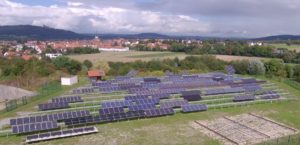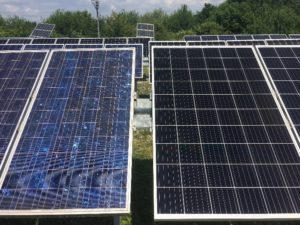 A walk through our test facility allows you to immerse yourself in the history of photovoltaics. Modules from many generations, some already a decade and a half old, show how technology has changed. Guest author and product manager René Schüler presents special test objects in a blog series and provides background knowledge to cell technologies and typical ageing effects. The blog series starts with a comparison between polycrystalline modules from 2004 and 2018.
A walk through our test facility allows you to immerse yourself in the history of photovoltaics. Modules from many generations, some already a decade and a half old, show how technology has changed. Guest author and product manager René Schüler presents special test objects in a blog series and provides background knowledge to cell technologies and typical ageing effects. The blog series starts with a comparison between polycrystalline modules from 2004 and 2018.
We have been operating our own photovoltaic test facility at a former landfill site on the outskirts of Bad Staffelstein in Upper Franconia since 2004. The total test surface currently covers 3,000 square metres. 62 individual systems made from polycrystalline and monocrystalline modules are currently installed on a total of 11 rows of modules.
Putting own and third party brands to the test
The tests at the test facility supplement the internal/external quality tests for the modules of our own brand and also offer the option of analysing modules from various manufacturers under real operating conditions both electrically and visually. Extensive analyses were performed at the test facility in the last 14 years. The experiences gained were incorporated into product development at IBC SOLAR, but were also passed on to the relevant manufacturers within the framework of the partnerships.

Grain boundaries then and now
A visual comparison between an older polycrystalline module (installed December 2004 with 150 Wp) with a current polycrystalline module (installed June 2018 with 285 Wp) clearly illustrates the development of the last one and a half decade. The grain boundaries still clearly visible at the time are only visible on closer inspection in current polycrystalline modules. This means they are visually similar to the solid, dark brown cell colour of the monocrystalline modules.
PERC concept and reduced frames
The first cell dimensions at the test facility amounted to 125 mm x 125 mm (5 inches) and are based on 2 conducting paths (busbars = BB). The dimensions of the oldest module at the test facility, the “IBC 120 S”, installed December 2004, were only 114 x 114 mm with 2 BB. The polycrystalline modules installed in the summer of 2018 are based on an optimised cell concept with di-electric rear surface passivation. The local aluminum contacts on the rear penetrate the di-electric surface of the PERC concept and ensure improved reflection properties for long-wave light with a reduced recombination speed of the carriers. The standard cell number has changed from an initial 12 cells per string to 10 cells per string. The module dimensions have only changed slightly at least in terms of length. A significant reduction in the frame height of the aluminum hollow chamber frame profiles from an impressive 55 mm to 40 or 35 mm, on the other hand, has been recorded in the last few years.